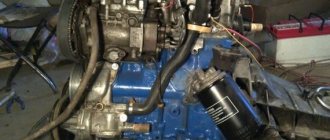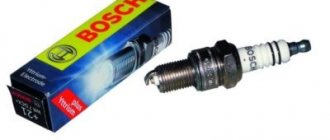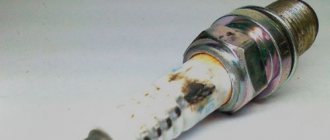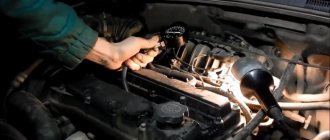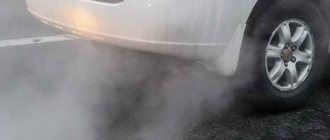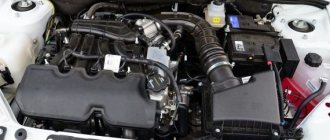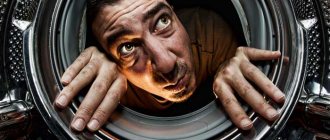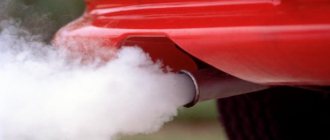Before you start looking for the causes of this problem and finding out what it can lead to, you need to understand what it means to trip an engine. Otherwise, this phenomenon is called “missing” and means interruptions in the operation of one or more cylinders of an internal combustion engine. The term “troit” owes its appearance to a four-cylinder internal combustion engine. If one of the cylinders fails, only three work. As a result, the engine does not pull, this becomes especially noticeable during acceleration. Currently, a six- and even twelve-cylinder power unit can “triple”, although this is not entirely true from the point of view of the Russian language. As a visual aid, you can find a video of an engine throttling on the Internet, and there you can also find a video about what to do in such situations.
You can tell that the engine has stalled by the changed sound of its operation. You can hear it especially well if you stand next to the exhaust pipe.
Other signs that accompany a malfunction are unstable idle speed, body vibrations, increased fuel consumption and loss of power (the engine does not pull).
Since each of the accompanying symptoms is also characteristic of other problems, they need to be considered only as a whole. You need to find out why the engine is failing as soon as possible, since the consequences of untimely repairs can become so serious that eventually the entire engine assembly will have to be replaced.
Signs of engine tripping
The main feature of the structure is a decrease in power. This happens due to the fact that the fuel-air mixture burns partially or even enters the exhaust manifold, where ignition occurs. The process is accompanied by strong vibration, which manifests itself in the following situations:
- idling, at high speeds the engine runs smoothly;
- engine heating mode;
- high load;
- tripping in any engine operating mode.
Each situation manifests itself under certain conditions.
Reasons: why the engine troits
Increased engine vibration occurs due to a violation of mixture formation. This leads to additional loads on the parts of the cylinder-piston and crank system, and therefore reduces their service life. Main reasons:
- fuel is supplied in a larger or smaller volume. With a larger volume of gasoline, the spark is not able to ignite the mixture fully, so when you press the accelerator pedal, the car begins to twitch, and the fuel continues to burn in the exhaust line. If there is a lack of fuel, the engine behaves the same way, but this can lead to burnout of the piston due to insufficient cooling from gasoline injection.
- lack of oxygen. The power unit behaves the same as when there is a lack of fuel. Air deficiency can be caused by a dirty air filter or a faulty oxygen sensor.
- The ignition system is not working correctly. The reasons lie in the setting of the ignition angle, where the spark may be supplied too early or late, and accordingly the mixture again burns incompletely. If the coil and spark plug are faulty, they also contribute to tripping. On carburetor engines with a distributor, the ignition angle often gets lost, which requires periodic adjustment.
- low compression. For this reason, complete combustion of the working mixture is impossible due to a violation of the cylinder seal. In this case, tripping is accompanied throughout the entire engine speed range, sometimes it may not appear until the engine reaches operating temperature.
Thus, the reason for the engine tripping lies in problems with the ignition system, fuel and intake systems. This most rarely occurs through a decrease in compression (at high mileage), which occurs due to an increase in the gap between the cylinder and the piston or due to burnout of the gas distribution valve.
Spark plugs are to blame
The first thing you should pay attention to is the condition of the spark plugs. The cause of tripping may be hidden in an incorrect gap between the electrodes, or in a breakdown of the spark plug. If adjusting the gap and cleaning from carbon deposits does not help, you should replace the spark plugs with new ones with the appropriate characteristics. It is recommended to change spark plugs every 20-30 thousand km.
Inspection of high-voltage wires
High-voltage ignition system wires are used on carburetor and injection units (with a single ignition coil). It is recommended to change BB wires every 50,000 km, as they are vulnerable to external aggressive environments. Wiring faults causing motor tripping:
- breakdown of the wire (in the dark a spark is visible from the broken surface of the wire),
- wear of rubber tips,
- The difference in resistance between the wires is above 4 kOhm.
Checking the wires is carried out with a multimeter: set the resistance value in kOhms, clamp the wire on both sides with probes. Normal resistance is 5 kOhm.
Air supply problems
Often the culprit for unstable operation of the internal combustion engine lies in the intake system. The injector is more vulnerable to the problem since the oxygen supply is scanned and regulated by sensors. List of possible faults:
- dirty throttle valve (the geometry of the air flow and its quantity are disrupted),
- the air filter is clogged,
- malfunction of the mass air flow sensor (mass air flow sensor) or the absolute pressure sensor and the intake temperature sensor (DBP + DTV),
- failure of the lambda probe (oxygen sensor),
- air leakage from the intake tract.
Any of the above breakdowns provokes a violation of mixture formation,
Malfunction of injectors and injector
Fuel injector failure is determined by mileage and fuel quality. List of possible faults:
- interruptions in the operation of the engine control unit,
- clogging of the nozzle (throughput decreases),
- a break in the electrical circuit with one of the injectors,
- strong fluctuations in pressure in the fuel rail,
- injector leaking.
To diagnose the injector fuel system, it is enough to “read” the ECU with a scanner for errors. If none are found, you need to wash the injectors with a special liquid, calibrate the throughput, replace the sealing collars, and at the same time change the fuel filter.
Diagnostic methods
If you are firmly convinced that the engine is malfunctioning, which is confirmed by the presence of most of the obvious symptoms, all that remains is to determine the cause of the malfunction. And this is a serious and time-consuming task that involves performing a large amount of work. But if you're lucky, the cause of tripling can be determined already at the initial stages of diagnosis. Strictly speaking, checking the engine condition can be done at any service station, and quickly and accurately, thanks to computer diagnostics.
But if you have extra time, and your finances are not so good, you can do all the work yourself. So, here is an approximate algorithm of actions:
- Since most often the cause of tripping is spark plugs and wires, the first thing we do is check their condition. The presence of black soot on the spark plug insulation will indicate its breakdown. Violation of the integrity of the wires is also unacceptable, since current leakage is possible in this place, especially with high humidity, and the spark plug in such cases will not be able to produce a spark of the required strength. The wires themselves may have damage (kinks, burnouts), but such problems cannot be detected by external inspection - you need to use a multimeter. The presence of carbon deposits on the electrodes is also a deviation from the norm, but it is by no means always the cause of the cylinder’s inoperability (this may be a consequence of other malfunctions);
- If no problems are found with the spark plugs and wires, we proceed to checking the air supply path. With its deficiency, the fuel assembly turns out to be enriched, and this is also one of the reasons for the tripping of the power unit. First of all, we check how tight the air ducts are, for which we shut off the supply pipe at the air filter in any convenient way, after which we use a compressor unit to pump air through a vacuum hose, providing a pressure of about 0.5-0.7 atmospheres. If a characteristic hissing sound is heard, the air duct has become depressurized. This threatens air leaks and a lean mixture. If the air filter is clogged, the situation will be exactly the opposite. The filter element will not be able to provide the required throughput, and the combustible mixture will be enriched;
- the next step is to check the condition of the throttle assembly sensor, as well as the air pressure sensor. This is done using a car scanner connected to the diagnostic connector. Faulty sensors should be replaced;
- The reason for the cylinder's inoperability may be a malfunction of the fuel supply system. Its operation is checked by measuring pressure using a pressure gauge, the output connector of which is connected to the injection rail. It should not exceed 7 atmospheres. Note that there is one nuance here - the measurement should be carried out four times: with the ignition on, with the engine running in idle mode, while the engine is running at operating speeds with the tube disconnected from the fuel pressure regulator valve, with the check valve tube blocked. At a pressure level less than the nominal one, we are most likely dealing with a breakdown of the fuel pump or pressure regulator valve. Otherwise, you should proceed to checking the functionality of the injectors. Usually they are the cause of a lean mixture, since they quickly become clogged, especially when using low-quality fuel. The most informative check of the condition of the fuel system is carried out using diagnostic equipment, which reports the presence of certain problems with the corresponding error code;
- the last stage is compression measurement, which is performed with a special tool, a compression meter. We insert its fitting into the hole of the inoperative spark plug, start the engine and increase its speed. The device readings are recorded several times for reliability. If the level of compression drop exceeds 15%, then we can talk about significant wear of the piston, rings or valve. For a more accurate diagnosis, partial disassembly of the power unit will be required.
https://www.youtube.com/watch?v=ephtWvjupAo
When an injection engine fails
If in the case of a carburetor engine the cause of the tripping is more or less easily determined, then in a fuel-injection engine it may not be so noticeable. The reason for this is the electronics, which control all processes in the machine.
The systems that such vehicles are equipped with are difficult to diagnose. For this reason, it is better for an inexperienced person not to even try to fix something. It is better to pay for computer diagnostics than to later spend money on expensive repairs due to improper maintenance of the injector.
The only thing you can check yourself in such an engine is the integrity of the wires and the condition of the spark plugs. The injectors can be checked as follows. Each injector is replaced with a serviceable one. If the friction in a particular cylinder has disappeared, then this part should be replaced. However, the nozzle itself can last quite a long time if it is properly cared for. The gasoline additive SGA will help with this.
Gasoline additive SGA. Cleaning the injector nozzles
As soon as the injection engine starts to fluctuate, you should immediately add this wash to the gasoline. It is better, of course, to do this as a preventive measure, and not when a problem has already appeared. It flushes the injector nozzles if they are clogged. In addition to this effect, the product prevents the formation of corrosion and plaque, due to which the nozzle will work intermittently.
In addition to caring for the fuel atomization system itself, flushing also has a positive effect on other elements. For example, the fuel pump, valves and other elements of the fuel supply and injection system.
If the use of the product does not bring the desired result and the engine continues to misfire, it means that the injector nozzles are already seriously clogged (this is if the motorist is sure that the problem is really in the injector) and flushing will not help.
Finding a broken cylinder
This task is not difficult. The only thing that needs to be done is to disconnect the tips of the high-voltage wires from the spark plugs one by one with the engine running. If you disconnect the working cylinder in this way, the sound of the motor will change, but if after disconnecting the tip the sound remains the same, it means that a non-working cylinder has been found.
When disconnecting high-voltage wires, you must be careful because the risk of electric shock is very high. This is not fatal, of course, but very unpleasant. First, you need to place a dielectric material under your feet, such as a dry board or rubber mat. Secondly, you need to disconnect it by holding the wire itself, and not the cap. Thirdly, you must not touch the car body during the procedure.
The easiest way to find a non-functioning cylinder is to use a personal scanner. For example, you can use the inexpensive universal device Rokodil ScanX Pro.
This scanner is compatible with most cars with an OBD2 connector and is very easy to use. All you need is to connect the device and run diagnostics.
In addition to the inoperative cylinder, the scanner will check the readings from all available sensors and, if detected, will issue the corresponding fault code.
If the engine stalls when cold
In autumn or in damp weather in summer, the engine may also stall, especially when starting in cold weather. If the problem disappears as soon as the engine warms up, then you should pay attention to the high-voltage wires. When the insulation wears out, energy loss occurs (breakdown of the shell), and a weak impulse is sent to the spark plugs. As soon as the car warms up and the moisture evaporates from the wires, the malfunction disappears because the leak resolves itself.
Because of this, even if a spark appears, its strength is not enough to ignite the air-fuel mixture. This problem can be solved by replacing the cable. It's better to change the whole set. Rather than face a similar malfunction of another wire after a while.
What to do first if the engine seizes up
Summarizing all of the above, we can draw up small instructions on what to do if symptoms of a throbbing engine appear.
First of all, it is necessary to note when it starts to trip: at startup, while cold or after warming up, at low or high speeds, during acceleration or without load. It is important to take into account in which cases the malfunction is more pronounced and only then begin to search for the cause.
If the engine shakes more when starting or when cold, you need to start your search by checking the spark plugs and high-voltage wires. If the problem becomes more pronounced after warming up or under load, it is better to first check the condition of the air filter.
It is better to check other possible reasons as the work becomes more complex.
What else is worth reading
Ignition system switch
Causes of engine overheating
Causes of carbon deposits on spark plugs
Malfunctions of the brake system of the VAZ 2110
Distributor
If the engine stalls at idle
Such a malfunction is diagnosed in the same way as tripping under load. There are no special reasons for this breakdown. When idling, the engine may begin to stall for the same reasons that have already been discussed above.
If the engine stalls exclusively at idle, and the problem disappears with increasing speed, the cause may be a burnt valve (minor degree). When compression increases under load (fuel and air do not have time to pass through the small hole in the burnt-out valve), the cylinder returns to its usual operating mode.
To make sure that the problem is a burnt-out valve, hold a sheet of paper near the exhaust pipe while the engine is running. If oil stains are clearly visible on it, you should contact a specialist.
Operation of vehicles
Answering the question whether it is possible to use a car when for some reason the engine is running rough, let’s say that experts do not recommend this practice. At such moments, there is an increased fuel consumption, which increases by 50-100 percent, and the fuel mixture, which is not burned in the damaged cylinder, causes troubles like:
- destruction of the catalyst;
- plaque formation on sensors;
- mixing fuel with lubricant in the crankcase;
Air pollution from exhaust gases with a high content of harmful substances should also be added to this list.
If these aspects do not scare you, then we also note the fact that when the engine (injector or diesel) is running, the crankshaft, CPG and internal combustion engine block are subject to increased loads, increasing the degree of wear of parts. Therefore, driving with such a malfunction can cause serious damage to the power unit, requiring significant financial expenses to restore its functionality.
What are the consequences of engine tripping?
If you do not pay attention to the engine tripping for a long time, then there is a high risk of getting into a major overhaul. The first to fail are the engine and gearbox mounts, which actively dampen vibrations. List of possible consequences:
- rapid wear of engine supports;
- an increase in the gap between the piston and the cylinder, as a result - a decrease in compression;
- high fuel consumption;
- failure of the oxygen sensor and catalyst due to high temperature in the exhaust system (fuel burns out in the exhaust manifold or resonator);
- increased consumption and coking of engine oil;
- The combustion chamber and engine cylinder become overgrown with carbon deposits.
What to do if the engine stalls: diagnostics and repair
When the first symptoms of tripping appear, it is necessary to perform electronic diagnostics of the engine. In most cases, the problem lies in a malfunction of the ignition system or one of the above-mentioned sensors.
If everything is in order, you should check the condition of the fuel and air filters, as well as the possible presence of suction (unaccounted air). If everything is in order with the fuel and intake system, all sensors are working properly - check the compression, and if it is below 11 kg/cm3, it means the gap between the cylinder and the piston has increased or the timing valve has burned out.
